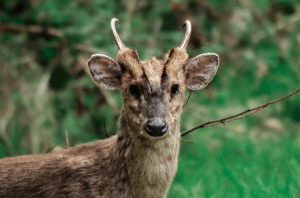Muntjac Deer Stalking And Hunting Around The World
MUNTJAC DEER / MUNTJAC DEER BUCKS / TROPHY MUNTJAC DEER / MUNTJAC DEER DOESYear Round Hunting, Exceptional Hospitality, Quality Trophies, Hunting For Meat
QUARRY
MUNTJAC DEER
SHOOTING STYLE
DRIVEN | HIGH SEAT | SPOT AND STALK
LOCATION
VARIOUS
SEASON
ALL YEAR DEPENDING ON COUNTRY
Hunting muntjac deer, also known as barking deer, offers a unique and challenging experience due to their elusive nature and small size. Native to South and Southeast Asia, including countries like India, Sri Lanka, and Thailand, muntjac have also been introduced to other regions, notably the United Kingdom, where they have established significant populations.
In the UK, muntjac deer hunting is popular in areas like Bedfordshire, Cambridgeshire, and Buckinghamshire. Hunters navigate through dense woodlands and underbrush, using stealth and patience to track these small, elusive deer. Their keen senses and tendency to stay hidden make the hunt particularly challenging.
In their native Asia, hunting muntjac often takes place in tropical forests and grasslands. The diverse habitats and the deer’s adaptability provide a varied hunting experience.
Whether in the dense forests of Asia or the woodlands of Europe, hunting muntjac deer is a pursuit that demands skill and offers a rewarding connection to nature and the thrill of the chase.
From £300
Would you like to learn more?
MUNTJAC HUNTING DESTINATIONS
Muntjac Deer Stalking In England
Muntjac hunting in England offers an exciting and challenging pursuit amidst the country’s picturesque woodlands and countryside. With established populations across various regions, including Bedfordshire, Cambridgeshire, and Norfolk, hunters have ample opportunities to stalk these elusive creatures. Known for their small size and elusive nature, muntjac deer present a thrilling challenge for hunters, requiring stealth and patience to track and take down. Whether pursued for sport or as part of conservation efforts to manage populations, muntjac hunting in England provides a rewarding and memorable experience in the heart of the British countryside.
Muntjac Deer Hunting In Sri Lanka
Muntjac hunting in Sri Lanka offers an adventurous pursuit amidst the country’s lush forests and diverse landscapes. Hunters navigate through dense vegetation, their senses heightened by the anticipation of encountering these elusive creatures. With their small size and cryptic behavior, muntjac present a challenging quarry, testing the skills and patience of even the most experienced hunters. Guided by knowledgeable outfitters, each hunt becomes a thrilling adventure, immersing hunters in the sights and sounds of Sri Lanka’s rich natural heritage. Against the backdrop of tropical forests and misty mountains, muntjac hunting in Sri Lanka is an unforgettable experience, blending tradition, excitement, and conservation.
Muntjac Deer Hunting In India
Year Round Hunting In Various Countries.
Exceptional Hospitality With Every Trip.
Experienced, Award Winning, Guides And Trip Organisers.
MUNTJAC DEER – MORE INFORMATION
Blank
The Red Deer
SCI Red Deer Scoring
The Safari Club International (SCI) scoring system for muntjac deer focuses primarily on the antlers and the tusks of these unique animals. Muntjac, also known as barking deer, have distinctive antlers and pronounced canine teeth, which are both considered in the scoring process. Here’s an overview of how muntjac deer are scored using the SCI system:
1. Antler Length: Measure the length of each antler from the base (where it attaches to the skull) to the tip. This measurement follows the outer curve of the antler.
2. Antler Circumference: Measure the circumference of the antler at the base. This is usually done at the narrowest point between the base and the first tine or the pedicle.
3. Antler Points: Count and measure the length of each tine or point on the antlers. Points must be at least one inch long to be included in the total score.
4. Spread of Antlers: Measure the spread of the antlers from the outer edge of one antler to the outer edge of the other at their widest point.
5. Tusks Length: Measure the length of the canine teeth (tusks) from the gum line to the tip. Tusks are more pronounced in males and are a notable feature of muntjac deer.
6. Symmetry: Consider the symmetry of the antlers and tusks, with more symmetrical specimens often scoring higher. However, symmetry is secondary to overall size and length.
Each measurement is recorded, and the total score is calculated by adding the lengths and circumferences of the antlers and tusks. The final score reflects the overall quality and size of the trophy.
The SCI scoring system for muntjac deer allows hunters to compare their trophies against others and to enter them into record books if they meet specific thresholds. This standardized approach promotes ethical hunting and conservation by recognizing exceptional specimens and encouraging sustainable wildlife management practices.
Where Can You Hunt Red Deer?
Here’s a list of countries where you can hunt muntjac deer:
United Kingdom: Particularly in areas like Bedfordshire, Cambridgeshire, and Buckinghamshire, where introduced populations have thrived.
India: Native populations in various states with suitable forest habitats.
Sri Lanka: Native populations in forests and grasslands.
Thailand: Native populations in tropical forests.
China: Native populations, particularly in southern and eastern regions.
Taiwan: Native populations in forested areas.
Vietnam: Native populations in forested regions.
Cambodia: Native populations in forests and grasslands.
Laos: Native populations in diverse habitats, including forests.
Indonesia: Native populations on some islands with suitable habitats.
These countries offer various opportunities for hunting muntjac deer, with regulations and hunting seasons that vary by region. Always ensure to comply with local laws and obtain the necessary permits before planning a hunting trip.
Muntjac Seasons
Seasons vary each year and from country to country so please get in touch for more details.
Would you like to learn more?
Muntjac Deer Stalking and Hunting Around The World
Fincal La Caminera
Widiane Chasse
Frochas
Despenadero Alto
Chateau Matra
Las Loberuelas

